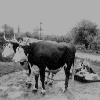 Raynardton
was once nothing more then a pathway through the woods, along the shore
of Lake Vaughn. Early settlers settled along the shore line, and used the
river as a highway. Timber and fishing were the main occupations and the
abundance of fish created lots of food. In the book The History of Yarmouth,
by Rev. J. R. Campbell, he described the water's fish supply as "Tusket
was so full of salmon, that the only way the fish could get up the river,
was over each other's backs." The first settlers around the 1750's were
Acadians. These settlers were attacked by an armed British ship, but were
able to defeat it, thus creating an ongoing story that the remains of the
boat were at the bottom of the lake. Not long after this victory, however,
they were attacked again, and this time mostly all were captured. Raynardton
was once nothing more then a pathway through the woods, along the shore
of Lake Vaughn. Early settlers settled along the shore line, and used the
river as a highway. Timber and fishing were the main occupations and the
abundance of fish created lots of food. In the book The History of Yarmouth,
by Rev. J. R. Campbell, he described the water's fish supply as "Tusket
was so full of salmon, that the only way the fish could get up the river,
was over each other's backs." The first settlers around the 1750's were
Acadians. These settlers were attacked by an armed British ship, but were
able to defeat it, thus creating an ongoing story that the remains of the
boat were at the bottom of the lake. Not long after this victory, however,
they were attacked again, and this time mostly all were captured.
JOB RAYNARD JOB RAYNARD The first settler to put down roots and start a community here was Job Raynard. He was born in England in 1763, and was a soldier in the War of Independence in New York. After the war he, and many other settlers, settled in Shelburne before coming to what is now Raynardton around 1791. Like most other places in Yarmouth at the time, the village was named for one of its first settlers, and this small place between Tusket Falls and Deerfield became Raynardton. Job built a house near Raynard's Bridge (which is today located on the dirt road) and named it "Laverton", after his English home. He built a saw mill, and raised 11 children. While married to Catherine (Gavel) Raynard, Job had seven children.
Job II ,the oldest, lived from 1800 to 1881, Edward 1804 to 1879. It is
unsure when the next son, William, was born, but he was married to Elizabeth
Hurlburt, daughter of William Hurlburt. Job's first daughter, Margaret,
married Joseph Kinney, son of John Kinney. His next daughter, Sarah, married
Wells Hamilton, son of Daniel Hamilton. Jane (who was born on August 10th,
1815) and Phoebe married brothers, both sons of Jacob Lyon Hatfield.
During his second marriage to Maria Horton in 1818, Job had four more children. The oldest daughter, Mary Ann, was born in 1820 and married James L. Hatfield (son of Abram Marsh) and Job's youngest daughter, Maria Marr (1823), married Aaron Blauvelt (son of Tunis). His youngest sons were both named after a family friend, Dr. Henry Greggs Farish. Henry Greggs was born in 1819 and married Deborah Roberts, daughter of John Roberts, while the next, George Farrish (1824-1895) married Jane Wilson, who had been widowed by Charles. Job Raynard, now a famous first settler, died on May 24, 1825. It is remembered by his Great-great-grandson, George, that Job died because of blood poisoning. He was poisoned when he tried to haul out his own tooth with a pair of pinchers, and it got infected. He was buried on his on property, and his friend, Dr. Henry Greggs Farish, planted a spruce tree at his head and grape vines at his feet. He also laid a simple stone engraved "J.R. Died 1825", which was found years later and is still kept in family possession. THE LAKE
THE LAKE LOCAL CITIZENS LOOKING OVER ROCKS AND STUMPS, UNVEILED BY THE WATER. IRVIN ANDREWS (FAR LEFT) WAS ONE OF THE MEN THAT HELPED CLEAR AWAY THE TREES The most important part of Raynardton is indeed the lake. The community is settled around Lake Vaughn, and it is used for fishing, swimming and wildlife. But the lake holds a history, and stories that are a part of Raynardton. Years ago, there was nothing but forests where the lake now is, and only a branch of the Tusket river for water supply. When the Tusket dam was built in 1929, the river overflowed, creating the lake. But before this, the forest had to be cleared. Dozens of local men cut and hauled the trees, many of them our great-grandfathers. The old road, which now lies under water, was the only source of transportation, so another road was built. This is the road we now use, although modernized since the time it was built. Under water in the lake are tree stumps, fence posts, and the old road,
showing the property lines, and designs of how our community once was.
When the lake is drained (it has been a few times the past few years to
work on the dam) you can see all of these, and much more. Ancient artifacts
have been found, including what some believe are Indian weapons, and old
tools and pottery.
|
|
|
|

GrassRoutes Computer Services
Ltd.
South Ohio, Yarmouth, Nova Scotia
Ph# 1-902-742-3845
Email: webmaster@grassroutes.com
All Rights Reserved